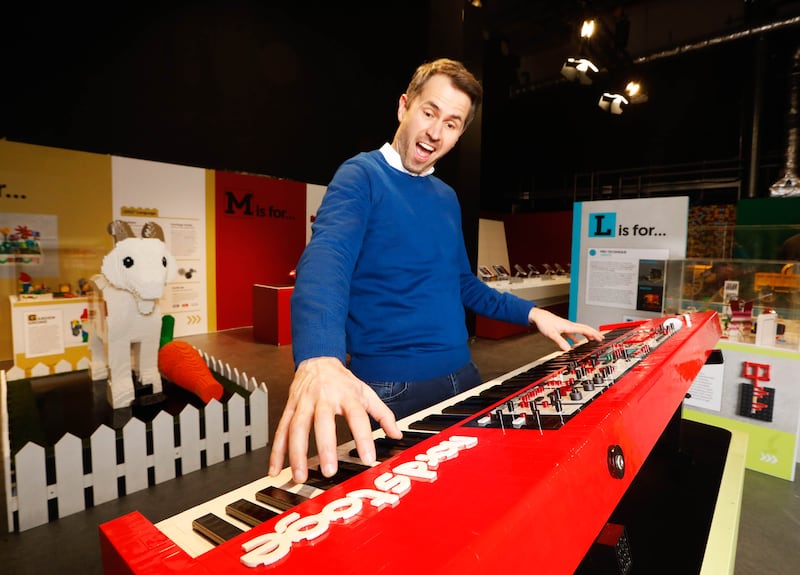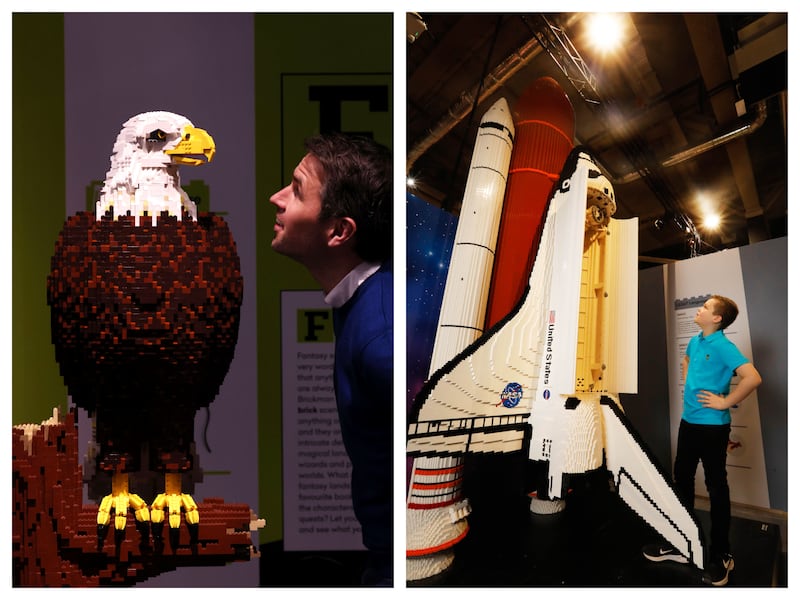It’s the faces that get you at Bricktionary. Lego, one of the world’s most flexible building toys, is based on a blocky system. Sure, they have are all sorts of fancy pieces and components these days, but the basis of Lego is the brick. And it’s notoriously (in certain circles) difficult to get a face right in Lego.
Among the many impressive items on display in Bricktionary, a touring interactive Lego exhibition Lego that opens today at the Theatre of Light, in Dublin’s Point Village, are the realistic faces of some of the model figures on display. Super Mario’s identity is spot on, vrooming in his car. Animal in the Muppets with his wild hair. And Mr Bean, in that scene where he’s in a chair strapped to the roof of his mini: the character and likenesses on their faces seem to belie the fact that they were built with blocky plastic bricks.
We may not be hugely familiar in these parts with Ryan McNaught, self-styled the Brickman, but in his native Australia his profile is high, primarily as a judge on Lego Masters Australia on TV.
He’s one of a limited number of “Lego certified professionals” worldwide, trusted by the Danish behemoth, and he has also built (boom!) an empire of several Lego-themed exhibitions that travel the world. These are not official Lego exhibitions, but McNaught himself has the Lego stamp of approval. There are currently about 10 Brickman exhibitions on the go internationally, of various sizes, including Jurassic World, Cities, Wonders of the World.
READ MORE
This one, based on McNaught’s book The Bricktionary: The Ultimate Lego A-Z, makes its European debut in Dublin this weekend.


The Irish Times dropped into the venue as the Brickman team was finishing the installation, to have a look, guided by head of exhibitions Simon Challenor. Based in Brisbane, he is constantly on the road internationally, setting up and supervising the installations of Brickman exhibitions, and scouting new locations.
The large open space is sectioned into different areas that broadly follow the alphabet. A is for Avengers, and Airship. B is for Bionicles (enormous builds of the small Lego transformer globes) or Buildings (a Shanghai Tower stretches upwards). C is for Costumes: this is a gorgeous shiny black “dress” on a mannekin, the dress entirely made from helicopter blades. D is for Diorama, and there are several creative scenes (from the Bates Motel to alien koalas) created by McNaught’s team of about 30 builders based mainly in Melbourne. “Ryan’s warehouse has millions and millions of every type of Lego brick.” Lego builder, dream job. Challoner says the ethos for building Lego is “just build what you want to build, don’t go by any pictures just build”.
E is for Eagle, and for Earthquake. There are smaller, intricate items and displays in Perspex display boxes, and larger models, some of which you can touch. Along with the way are displays with information about the models, challenges, techniques, tips and titbits about the Lego world, including I for Illegal, or the use of bricks that Lego frowns on because they strain the pieces.
Among the larger models are a detailed space shuttle about two metres tall, and a tree filled with birds; this is one of the more complicated structures to build; it’s 600kg of bricks, and involves a wide horizontal leaf mass and various branches, sitting on a slim trunk. K is for Keyboard, a red life-size replica so true you feel you could play the keys. P is for pop art. R is for Robot (including a fantastic mech).

There are four interactive areas among these, where visitors can build. Open counters with tubs of miscellaneous invite you to a challenge: In the Earthquake area, to build a stronger structure that will withstand placing it on a vibrating pad; wall displays suggest ways to make it stronger.
M is for Minifigure. It’s also for Mosaic, an interactive space where visitors can make a little mosaic “tile” (according to a guide on screen), that is added to a large board which is the base for a pre-planned giant scene, which will comprise 3,200 mosaic tiles, each one made with 36 individual 1x1s, those tiny Lego pieces you lose down the back of the couch. (That’s 115,200 of the 1x1s; it takes about three weeks to make the mosaic, whose progress you can follow online; then a new one starts).
The other two interactive areas involve building a bird or creature to add to the tree (or the “grass” surrounding it) and a robot-building area.
“There’s about 6,000 hours worth of building in this exhibition. That’s like a year for one person full time”, says Challoner. “There’s about a million bricks in the builds. And there’s about another half a million bricks for people to play with.”
The figure of Animal, for example, is about 50cm tall, probably has about 8,000 pieces, and took about 70 or 80 hours to build, he says. The complexity of his wild hair was a challenge to plan; models like these can take more time than some larger models with more wall-like sections.
The logistics of the travelling exhibition involve packing and transporting Lego models, with the larger ones breaking into a few sections, then assembled on site by the team. Once the models are created and built, says Challoner, the bricks are glued together, aside from where the sections come apart for transport.

All the same, a proportion of Lego pieces (usually from the interactive areas) are lost each week (losing one brick per person visiting is doing well, he reckons). They are replaced from their on-site storage, which must be impressive. “I have tubs and tubs and tubs. So yeah, we’re just topping up the interactive areas constantly.”
Bricktionary exhibitions in different locations worldwide simultaneously have the same format, but each has different Lego models and displays. This exhibition is expected to be in Dublin for six months. The alphabetical riffs are charmingly varied, and the intricate detail is very impressive, whether in the more complex facsimiles or in the imaginative leaps of fancy.
The organisers expect lots of families with children to visit, but also grown-up Lego-heads (and there are many of them). You could easily spend an hour and a half here, including making stuff with the Lego pieces in the interactive areas, or you could bury yourself for longer.
Bricktionary interactive Lego exhibition opens on Sunday, March 10th at the Theatre of Light, in Dublin’s Point Village. Tickets are priced dynamically, so they vary by day/time, and prices go up from €15 per adult, €12 child, €45 family, all plus fees. Ryan McNaught leads in-person masterclasses on Monday and Tuesday.
- Listen to our Inside Politics Podcast for the latest analysis and chat
- Sign up for push alerts and have the best news, analysis and comment delivered directly to your phone
- Find The Irish Times on WhatsApp and stay up to date












